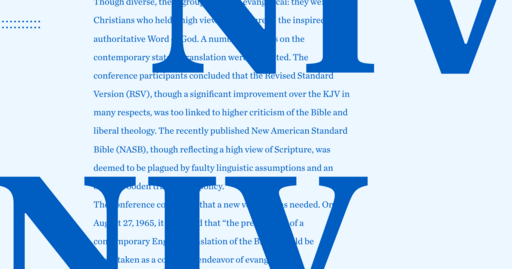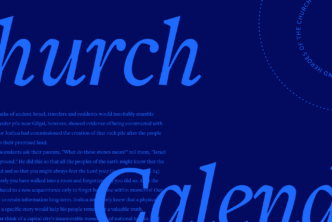Since the mid-1980s, the New International Version (NIV) has been the best-selling English-language Bible, both in the United States and worldwide.1 The NIV was a trans-denominational effort by over a hundred scholars, sponsored by the nonprofit New York Bible Society (NYBS). The full Bible was released in 1978, with major revisions in 1984 and 2011. This article surveys the translation’s origin, production, remarkable success, recent controversies, and present place in the world of English Bible translation.
The origin of the NIV2
The vision for the NIV began in the 1950s with a Christian businessman named Howard Long. An avid evangelist, Long found the King James Version (KJV) increasingly inadequate for sharing his faith. Though he personally loved the KJV’s style and noble prose, he was often met with incomprehension and derision when quoting verses from it to others. A member of the Christian Reformed Church (CRC), Long approached his pastor, Peter De Jong, who showed great interest and began to advocate within the denomination for a new translation. After a series of delays and setbacks, a proposal for a new translation was eventually approved at the 1958 annual Synod of the CRC. Meanwhile, similar proposals for a new Bible translation were making their way through committees of the National Association of Evangelicals (NAE). Made up of thirty denominations and hundreds of individual churches, the NAE had been formed in 1942 in response to the liberalizing tendencies of the National Council of Churches.
The NAE and the CRC eventually came together and formed a joint committee, which in 1965 called a conference on Bible translation at Trinity Christian College in Palos Heights, Illinois. Present at this conference were members of twenty-eight evangelical theological institutions and a wide variety of denominations:
- Assemblies of God
- Baptist
- Christian Reformed
- Lutheran
- Mennonite
- Methodist
- Nazarene
- Presbyterian
Though diverse, these groups were all evangelical: they were Christians who held a high view of Scripture as the inspired and authoritative Word of God. A number of papers on the contemporary state of translation were presented. The conference participants concluded that the Revised Standard Version (RSV), though a significant improvement over the KJV in many respects, was too linked to higher criticism of the Bible and liberal theology. The recently published New American Standard Bible (NASB), though reflecting a high view of Scripture, was deemed to be plagued by faulty linguistic assumptions and an overly wooden translation policy.
The conference concluded that a new version was needed. On August 27, 1965, it proposed that “the preparation of a contemporary English translation of the Bible should be undertaken as a collegiate endeavor of evangelical scholars.”3 A committee of fifteen members, called the Committee on Bible Translation (CBT), oversaw the project; but the translation process involved over a hundred evangelical scholars. Funding came from the New York Bible Society (NYBS), which almost went bankrupt in the process. Some board members of the NYBS actually mortgaged their homes to keep the society alive and the translation moving forward. Zondervan Publishers eventually stepped in and provided advance royalties to see the project through to completion.
Production of the NIV
The NIV is a committee translation as opposed to the work of a single translator. And it is a new version translated directly from the Hebrew and Greek, rather than a revision of a previous English version. The primary text used for the Old Testament was R. Kittel’s Biblica Hebraica (and later, Biblia Hebraica Stuttgartensia) and for the New Testament, the latest critical edition of the Greek New Testament of the United Bible Societies, together with the latest edition of Eberhard Nestle’s Novum Testamentum Graece.4 Biblical texts were assigned, book by book, to translation teams made up of two translators, two translation consultants who were biblical scholars, and a stylist consultant (when available). These teams produced an initial translation following a translation manual produced by the CBT. The translation was then submitted to three successive editorial committees, which included examinations not only by biblical scholars but also by theologians and English stylists. The theologians were to represent the concerns of various confessional traditions; the stylists were to make sure the text represented good English and that it read well orally. Final decisions were made by the fifteen-member CBT.
The New Testament of the NIV was released in 1973 and the whole Bible in 1978. The CBT has continued to meet annually ever since to examine, discuss, and vote on proposals for revision. A supermajority vote of 70 percent of the CBT is required to make changes to the text. In 1984, a new edition was released incorporating decisions made by the CBT since 1978. This 1984 edition was the standard edition of the NIV until the latest revision in 2011.
In 1988 the New York Bible Society was renamed the International Bible Society (IBS) to more accurately reflect its mission as an international Bible translation and distribution ministry. In 2009 it was again renamed Biblica. While Biblica holds the copyright to the NIV and publishes editions for ministry purposes, Zondervan Publishers has the primary rights to commercial publication in the United States, and Hodder and Stoughton has the same rights in the United Kingdom. There is an Anglicized edition of the NIV published in the United Kingdom.
The NIV’s success
The NIV’s popularity soared in the years following its publication, and by the mid-1980s it was annually outselling the previously dominant KJV. At one point, the NIV achieved approximately 40 percent of English Bible translation marketshare. The publication of the popular NIV Study Bible (NIVSB) in 1985 helped to propel this success forward. The NIVSB was one of the first study Bibles whose notes were primarily exegetical rather than theological, which made it particularly helpful for Bible study.
Today, over 500 million copies of the NIV have been sold worldwide, and millions more have been distributed freely by Biblica. Two decisive factors working in tandem appear to have contributed to the NIV’s remarkable success:
- Its readability by virtue of its mediating translation philosophy
- Its evangelical credentials
By adopting a meaning-for-meaning rather than a word-for-word approach to translation—a method known in translation circles as dynamic or functional equivalence5—the NIV was far more readable than its more literal counterparts like the RSV and the NASB. At the same time, it was significantly more formal than “natural language” versions like the Living Bible (LB; 1971) and Today’s English Version (TEV; NT 1966). Because these latter used everyday English, people who grew up in the church often considered them to be mere “paraphrases.” Neither sounded like the “real Bible,” that is, the KJV! Stuffy biblical scholars would scoff that these versions were fine for devotional reading and remedial readers, but they were inadequate for serious study.
This was the beauty of the NIV. Though it was clear and understandable, it kept much of the cadence of the KJV, particularly in well-known passages. One of my favorite examples is Psalm 23:1, which the NIV rendered, “The Lord is my shepherd, I shall not be in want.” The phrase “be in want” is hardly natural English. But this is perhaps the most beloved and well-known psalm in the Psalter, and the KJV reads, “I shall not want.” The NIV still reverberated with the sound and rhythm of the KJV, but in more contemporary English.6 This balanced approach—idiomatic yet traditional—helps to explain why the NIV surpassed its competitors, even the revered KJV.
The second factor that contributed greatly to the NIV’s success was its evangelical credentials. The version was developed by a broad and influential coalition of evangelical scholars who first produced and then promoted the translation. The one-hundred-plus translators came from a wide range of evangelical theological institutions. The fifteen original CBT members included scholars from:
- Southwestern Baptist Theological Seminary
- Westminster Theological Seminary
- Nazarene Theological Seminary
- Gordon Divinity School
- Covenant Theological Seminary
- Conservative Baptist Theological Seminary
- Trinity Evangelical Divinity School
- Bethel College
- Houghton College
- Dallas Theological Seminary
- Calvin Theological Seminary
- Goshen Biblical Seminary
Replacements after death or retirement included scholars from Regent College, Westmont College, Tyndale Theological Seminary, Wheaton College, and others.7 The RSV had a strong coalition of mainline denominational support; the NIV’s evangelical credentials brought much greater acceptance in the conservative Christian world. (And it is evangelicals who buy the most Bibles!)
The preface to the NIV makes this theological perspective clear, noting that “the translators were united in their commitment to the authority and infallibility of the Bible as God’s Word in written form.”8
All NIV translators were required to sign either the Evangelical Theological Society statement of faith or a similar evangelical confession.9
Criticism and controversy
Most Bible versions are met with a measure of criticism and opposition, and the NIV was no exception. Some critics attacked the NIV because of its meaning-for-meaning rather than a word-for-word approach to translation.10 Others attacked the NIV—as they did virtually all modern Bible versions—for favoring readings from the earlier Alexandrian New Testament manuscripts rather than the Textus Receptus, the family of Greek NT editions underlying the KJV. Neither of these criticisms did much to slow the NIV’s success. Those with linguistic expertise and especially international Bible translators affirmed the superiority of functional equivalence over a literalist approach, and virtually all New Testament scholars—including the great majority of evangelical ones—recognize the superiority of the earlier Greek manuscripts.
A different kind of controversy broke out in March of 1997, however, when World magazine published an article called, “The Stealth Bible: The Popular New International Version Bible Is Quietly Going ‘Gender-Neutral.’”11 The article charged that a “gender-neutral” version of the NIV had been recently published in Great Britain and a similar version would soon be introduced in North America. Stoked by evangelical fears of feminism, together with the description of this edition as a “stealth” Bible, the article created a sensation. Complaints began to pour in at the International Bible Society (IBS) and Zondervan. One man even drilled holes through several NIVs—meant to look like bullet holes—and sent these Bibles to the IBS.12 Zondervan and the IBS moved rapidly for damage control, releasing press statements explaining that gender-inclusive language was being introduced only when warranted by the meaning of the original text and in line with contemporary English usage. For example, the Hebrew word ’adam and the Greek anthrōpos usually meant “human being” rather than “man,” and so it was actually more accurate to translate them with inclusive terms like “person.” Despite this call for calm and reason, public outrage grew. When the nation’s largest denomination, the Southern Baptist Convention, threatened to drop the NIV from its Sunday school curriculum, the IBS reversed course, issuing a statement abandoning all plans for gender-related changes in future editions of the NIV.
This decision, however, was quickly recognized as reactionary and nearsighted by the leadership of the IBS and Zondervan. Indeed, it contradicted the original mandate of the NIV, which was to periodically update the text to keep it in line with contemporary English. Having frozen the NIV in its 1984 version, the IBS decided to produce a new version to carry forward changes deemed necessary for the translation’s continued relevance. This new edition was titled Today’s New International Version (TNIV). The New Testament was released in 2001 and the whole Bible in 2005. While many critics viewed the TNIV simply as a “gender-neutral” NIV, in fact it represented the scholarly discussions and votes of the NIV’s Committee on Bible Translation (CBT) from the previous twenty years (1984–2005). Its purpose was to continue the NIV’s legacy of accuracy and clarity.
The NIV 2011
Despite a strong marketing push, the TNIV was ferociously attacked by its critics. Over a ten-year span the translation never achieved more than 1 percent of the English Bible market share. Many Christian bookstores refused to stock it. In the face of little support for the TNIV and declining NIV sales, in 2009 the IBS and Zondervan changed course. They brought in a consultant who reviewed the entire history of the debate and advised that the TNIV should be discontinued and the NIV revised to take into account gender-language changes in English. Not wanting to be accused of producing another “stealth” version, Zondervan and the IBS widely publicized this new direction. In addition, Zondervan commissioned the Collins Dictionary group to conduct a major study of contemporary English to gain empirical data concerning the present state of its gender language. The CBT used the findings of this study to help guide their decisions.
After several years re-examining and discussing every gender reference in the Bible, the CBT produced the next generation of the NIV. It was published in 2011, coincidentally during the four hundredth anniversary year of the publication of the King James Version. The 2011 NIV retained many of the gender changes introduced in the TNIV but rolled back others that were viewed as controversial.
In retrospect, the gender-language debate that produced such controversy is now viewed by many as a “a tempest in a teapot” (one scholar’s description to me). On the one hand, the use of gender-inclusive terms for masculine generics in translation was not new, and every English translation since Wycliffe and Tyndale has used some inclusive terms for masculine generics. The King James Version, for example, commonly used the gender-neutral “children” instead of “sons” to translate masculine plural terms in Hebrew (banim) and Greek (huioi).
It is true, of course, that the use of gender-inclusive language in English has increased dramatically in recent years, both in society and in Bible translation. Whatever you think of the cultural forces helping to drive these changes, it is impossible to deny that English usage has changed. Using “men” when referring to both women and men sounds odd and inaccurate to most of us. If I were preaching today and said, “All men should follow Jesus,” I think the majority of the congregation would hear this as a reference to males. It is more accurate to say, “All people should follow Jesus.” Indeed, this use of inclusive language is appropriately called gender-accurate rather than gender-neutral. The goal is not to abolish gender distinctions but to clarify them.
Even before the NIV controversy in the mid-90s, at least ten major English versions had already introduced this kind of gender-inclusive language.13 So why so much controversy over the NIV? It seems that the NIV, which by this time had become the premier English Bible for evangelicals, was a victim of its own success. The earlier and more comprehensive gender-language changes of the NRSV (1989) could be shrugged off because it, like its predecessor the RSV, was viewed by many evangelicals as a “liberal” version. Similarly, the gender-inclusive language in versions like the New Century Version (NCV; 1987), the Good News Translation (GNT; 1992), and the New Living Translation (NLT; 1996) could be forgiven, since these were viewed by many as paraphrases, unsuitable for serious study. But the NIV was the real Bible—the primary text of Scripture for millions of evangelicals. When the NIV translators were accused of caving in to a feminist agenda, the response was overwhelming. The title of one article in Christianity Today sums up the evangelical response: “Hands Off My NIV!”14
Ironically, however, even versions that arose in part as a reaction against gender-inclusive versions were moving in this direction. The English Standard Version (2001), a revision of the RSV (1952), dropped the words “man” and “men” from the RSV almost seven hundred times! Similarly, the Holman Christian Standard Bible (2001), which was produced in a context of general antipathy toward gender-inclusive language, was revised in 2017 and renamed the Christian Standard Bible (CSB). While the HCSB used the terms “man” or “men” 3097 times, the CSB uses it only 2551 times, a reduction of 546! While the HCSB had consistently translated adelphoi as “brothers,” the CSB now has “brothers and sisters” 145 times.15 Perhaps most surprising, the 2020 revision of the NASB — known for its consistently literal approach—has introduced a great deal of gender-inclusive language. Whereas the 1977 edition used “man” or “men” 3896 times throughout the Bible, and the 1995 revision slightly fewer at 3847 times, the 2020 has these masculine terms only 2625 times, a reduction of 1226. Similarly, whereas the NASB consistently translated adelphoi as “brethren,” the NASB 2020 now commonly renders it as “brothers and sisters” (131 times).
Remarkably, many of those who twenty years ago were vehemently attacking the revisers of the NIV for their use of gender-inclusive language are now adopting much of this same language in their own versions. This would seem to provide a measure of vindication for those who insisted all along that the goal was to achieve gender accuracy rather than gender neutrality.
The changing landscape of Bible versions
The NIV is the only English version since the KJV that has come close to becoming the “standard” English version. Yet today, the Bible translation landscape is changing. While the NIV remains the best-selling and most popular English version in the world today, its dominance has waned. A number of factors have contributed to these changes. First, as noted above, the negative publicity generated by the gender-language debate shook some people’s confidence in the NIV brand. Despite a more nuanced understanding of these issues today and the widespread adoption of such language in even the most conservative English Bible versions, it is hard to restore full confidence once it has been lost.
Second, the field of English Bible versions had become significantly more crowded. When it was first translated, the NIV was almost alone in occupying a mediating position between the main formal-equivalent (e.g., KJV, RSV, NASB) and functional-equivalent versions (e.g., LB, TEV). Competing now for this middle ground are a number of versions like the Common English Bible (CEB; 2011), New English Translation (NET), and the CSB (2017).16 These versions have also chipped away readers from various constituencies. For example, the (H)CSB was produced in Southern Baptist Convention (SBC) circles, historically a major constituency of the NIV. The CEB is directed toward more mainline denominations, where the NIV has also been historically popular.
Third, just as new mediating versions have challenged the center of the translation spectrum, so the increasing sophistication of functional-equivalent versions like the NLT 2014 has eroded NIV support from the more idiomatic or natural-language side of the translation spectrum (cf. GNT, NCV, GW, CEV, etc.). While natural-language versions like these were once dismissed as mere paraphrases, they are now recognized as works of scholarship, the products of highly competent biblical scholars.
On the more formal or “literal” side of the translation spectrum, a new edition of the NRSV (2022), improvements in readability in the NASB (2020), and the rising popularity of the ESV (2001), have further chipped away at the NIV’s preeminence. Many evangelicals appreciated the scholarship and window on the Hebrew and Greek provided by the RSV, but did not like its reputation as a “liberal” version. The ESV, which may be seen as an “evangelicalized” RSV, changed these offensive passages, making it the translation of choice among some who prefer a more formalist approach.
Conclusion
I am of two minds in this changing world. In my teaching, I have always encouraged the use of multiple Bible versions from across the translation spectrum. So I rejoice in the abundance of excellent English versions and the additional insight and clarity they bring to our study of the Word. At the same time, as one who was nurtured on the KJV and then matured on the NIV, I long for a simpler day when I could say, “Turn in your Bibles to …” and we would all be reading the same words! I also grieve at the sometimes prideful approach that insists, “My Bible is better than yours,” and criticizes others rather than praising and utilizing the wealth of resources available today.
Let us thank God for the many excellent English versions we have at our disposal and continue to pray that God would send workers into the field to finish the task of translating God’s Word into the heart languages of every nation, tribe, and people.
Related articles
- The Best Bible Translations: All You Need to Know & How to Choose
- Bible Translations: Wisdom in Choosing the Right One
- Much of this article was adapted from Mark L. Strauss, 40 Questions About Bible Translation (Grand Rapids, MI: Kregel Publications, 2023). Forthcoming. Used by permission of the publisher.
- Histories of the origin of the NIV can be found in a number of works, including Carolyn J. Youngblood, “The New International Version Translation Project: Its Conception and Implementation,” Journal of the Evangelical Theological Society 21 (September 1978): 239–49; Kenneth L. Barker, ed., The NIV: The Making of a Contemporary Translation (Grand Rapids, MI: Zondervan, 1986); Richard K. Barnard, God’s Word in Our Language: The Story of the New International Version (Colorado Springs: International Bible Society, 1989); Burton L. Goddard, The NIV Story: The Inside Story of the New International Version (New York: Vantage, 1989); John H. Stek, “The New International Version: How It Came to Be,” in The Challenge of Bible Translation: Communicating God’s Word to the World, eds. Festschrift Ronald F. Youngblood et al. (Grand Rapids, MI: Zondervan, 2003), 235–63.
- Stek, “New International Version,” 244.
- Note: these titles link not to the editions of the Greek New Testament that were used for the NIV at the time but to the latest editions of those same texts as of the time of publication.
- Based especially on the linguistic theories of Eugene Nida and his colleagues at Wycliffe Bible Translators and the United Bible Societies. See especially Eugene A. Nida and Charles R. Taber, The Theory and Practice of Translation (Leiden: Brill, 1974); Jan de Waard and Eugene A. Nida, From One Language to Another: Functional Equivalence in Bible Translating (Nashville: Nelson, 1986).
- Incidentally, in the NIV 2011 edition, the CBT finally changed this to natural English: “The Lord is my shepherd, I lack nothing.”
- For lists of names, see Stek, “New International Version,” 245; and Michael Marlowe, “The NIV Committee on Bible Translation,” Bible Research, www.bible-researcher.com/niv-translators.html. Accessed January 31, 2023.
- “Preface,” in The Holy Bible: New International Version (Grand Rapids: Zondervan, 1984).
- These include, “The Westminster Confession, the Belgic Confession, the New Hampshire Confession, or the creedal basis of the National Association of Evangelicals; or some other comparable statement.” Stek, “New International Version,” 246.
- See, for example, Robert Martin, Accuracy of Translation (1989; repr., London: Banner of Truth, 1997). This book was responded to by Kenneth Barker in Accuracy Defined and Illustrated (Colorado Springs: International Bible Society, 1995).
- Susan Olasky, “The Stealth Bible: The Popular New International Version Bible Is Quietly Going ‘Gender-Neutral,'” World Magazine (March 29, 1997), 12–15. For details of the controversy and response, see Mark L. Strauss, Distorting Scripture? The Challenge of Bible Translation & Gender Accuracy (Downer’s Grove: InterVarsity Press, 1998).
- Doug LeBlanc, “Hands Off My NIV!,” Christianity Today 41, no. 6 (June 16, 1997), 53.
- These included New Jerusalem Bible (NJB, 1985), New Century Version (NCV, 1987), New American Bible (1988 revision), New Revised Standard Version (1989), Revised English Bible (1989), Good News Translation (1992 revision), The Message (1993), Contemporary English Version (1995), God’s Word (1995), and New Living Translation (1996). For details see Strauss, Distorting Scripture?, 39–59.
- LeBlanc, “Hands Off My NIV!”
- For more details, see Mark L. Strauss, “A Review of the Christian Standard Bible,” Themelios 44, no. 2 (2019): 258–77.
- See also the Revised English Bible (REB; 1989), the New American Bible (NAB), and the New Jerusalem Bible (NJB).







